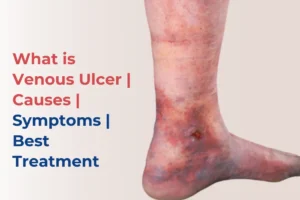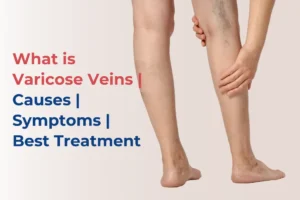
How to Avoid Varicose Veins | Top 5 Prevention Tips
How to Avoid Varicose Veins | Top 5 Prevention Tips Varicose veins are more than just visible blue lines beneath your skin — they are

Varicose veins are more than just a cosmetic concern. For many patients, especially those who delay treatment, these enlarged, twisted veins often come with another distressing symptom: skin discoloration. But is there a real medical connection between varicose veins and skin discoloration? The answer is yes. When left untreated, varicose veins can cause progressive damage to the skin, leading to changes in color, texture, and in some cases, ulceration.
This blog dives deep into the link between varicose veins and skin discoloration, explains the stages of vein disease, and outlines effective treatments. If you’re facing symptoms of vein problems, Dr. Santosh Patil – Best Vascular Surgeon in Pune, offers expert diagnosis and cutting-edge solutions tailored to your condition.
Varicose veins result from venous insufficiency, a condition where the one-way valves in your veins become weak or damaged. When this happens, blood begins to pool in the legs instead of flowing efficiently back to the heart. Over time, this pressure builds and causes the veins to stretch and bulge, often becoming visible through the skin.
As pressure continues to rise in these veins, the surrounding tissues are affected. The most common site of visible changes is the skin of the lower legs and ankles, an area particularly vulnerable to chronic venous insufficiency (CVI).
Skin discoloration related to varicose veins typically appears as a reddish-brown or purplish tint on the lower legs. It may start as mild redness or rash-like irritation and progress to darker pigmentation as the condition worsens. This condition is often known as venous stasis dermatitis or venous eczema.
As venous pressure increases, small blood vessels (capillaries) near the skin’s surface rupture, leaking blood into the surrounding tissues. Hemoglobin from the red blood cells breaks down and leaves behind iron deposits in the skin. This leads to a rusty brown discoloration that may spread and worsen over time. Without timely intervention, the skin can become hardened (lipodermatosclerosis), dry, itchy, or inflamed, and may eventually ulcerate.
These symptoms are a warning sign that your veins are not functioning properly, and delaying treatment can lead to complications like venous ulcers or infections.
If your legs show any signs of skin discoloration, heaviness, swelling, or itching, it’s time to consult a vascular expert. These symptoms indicate advancing vein disease that requires professional treatment. Dr. Santosh Patil, recognized as the Best Vascular Surgeon in Pune, is highly experienced in diagnosing and managing all stages of venous disease, including skin changes and ulcers.
A detailed clinical examination followed by a Doppler ultrasound is the gold standard for evaluating venous insufficiency. It helps locate faulty valves, measure vein diameter, and detect clots or reflux.
Dr. Santosh Patil uses advanced duplex ultrasound techniques to ensure pinpoint diagnosis and treatment planning for patients dealing with varicose veins and skin discoloration.
Conservative Management
Minimally Invasive Procedures
a. Radiofrequency Ablation (RFA) Heat is used to seal the affected vein, leading to its gradual absorption by the body.
b. Endovenous Laser Treatment (EVLT) Similar to RFA but utilizes laser energy.
c. Sclerotherapy A chemical solution is injected to close small varicose and spider veins.
d. VenaSeal Closure System A medical adhesive is used to close the vein, eliminating the need for thermal energy.
Surgical Options
Dr. Santosh Patil is highly skilled in all modern vein treatment techniques and ensures personalized care for women suffering from varicose veins in Pune.
Yes, if treated early. When varicose veins are treated, especially through RFA or EVLA, the excess pressure is relieved, and the skin begins to heal. Topical care combined with improved blood flow allows the discoloration to fade gradually. However, long-standing skin changes may take longer to resolve or may require dermatological intervention for full recovery.
With vast experience and a reputation for excellence, Dr. Santosh Patil – Best Vascular Surgeon in Pune, specializes in advanced, patient-focused treatment for vein conditions. From diagnosis to follow-up, he offers personalized care that addresses both medical and cosmetic concerns.
He is trusted for:
The connection between varicose veins and skin discoloration is medically significant and not just cosmetic. Discoloration is often a sign of worsening vein disease, and delaying care can result in complications like ulcers or infection. Fortunately, with early detection and expert treatment by Dr. Santosh Patil, patients can expect remarkable recovery both in function and skin appearance.
If you or someone you know is dealing with skin changes in the legs, don’t ignore the symptoms. Schedule a consultation with Pune’s leading vein specialist and take control of your vascular health today.

How to Avoid Varicose Veins | Top 5 Prevention Tips Varicose veins are more than just visible blue lines beneath your skin — they are

What is Venous Ulcer | Causes | Symptoms | Best Treatment & Best Vascular Surgeon Venous ulcers are one of the most common types of

What is Varicose Veins, Causes, Symptoms, Treatment & Best Vascular Surgeon Varicose veins are more than just a cosmetic concern. For many people, they represent

We offer a broad range of nonsurgical treatment options that solve various problems and instill a renewed zest in patient’s life.
Interventional Radiologist in Pune | Varicose Vein Treatment in Pune | Vascular Surgeon in Pune | Interventional Radiologist in Kharadi | Interventional Radiologist in Baner | Varicose vein treatment cost in Pune | Varicocele embolization cost in Pune | Varicocele surgery cost in Pune | Best doctor for varicose veins | Vascular Specialist in Pune | Varicose Vein Treatment in Kharadi | Varicose Vein Treatment in Baner | Interventional Radiologist in Wakad | Interventional Radiologist in Aundh | Interventional Radiologist in Pimple Saudagar | Varicose Vein Treatment in Aundh | Varicose Vein Treatment in Wakad | Varicose treatment near me | Varicose vein specialist in Pune | Veins doctor near me | Varicose treatment near me | Laser treatment for varicose veins | Varicose veins laser treatment cost | Varicose veins laser treatment cost in Pune | Thyroid Nodule ablation cost | Uterine Fibroid Embolization cost | Varicocele surgery cost in Mumbai | Varicose vein treatment cost in Pune | Varicocele embolization cost in Pune | Varicocele surgery cost in Pune | Venaseal treatment in Pune | Venaseal treatment for varicose vein
WhatsApp us